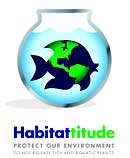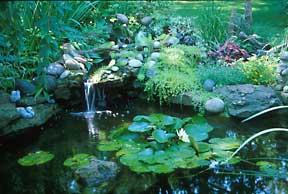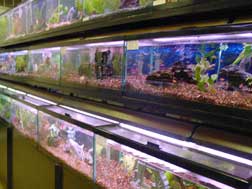 |
|||||||||
skip to content |
|||||||||
A New 'Habitattitude' ™ Can Help Prevent the Spread of Aquatic Invasive Species
By Irene Miles and Marie Zhuikov

"Non-native plants and animals can cause irreparable harm to the environment and can damage recreational and commercial uses of our aquatic resources," said retired Navy Vice Admiral Conrad C. Lautenbacher
What is the best way to deal with unwanted live aquarium fish? If your idea is to set them free in a nearby waterway, think again. You may be releasing non-native species that can cause negative environmental, economic, and human health impacts.
Water gardening provides an opportunity to create beautiful environments in one's yard, but water gardeners need to understand the potential risk of spreading AIS. (Photo courtesy of Watergardening Magazine) |
"Don't release fish and aquatic plants" is the message of a new national education program called Habitattitude ™ that teams up business, government, and academia to inform aquarium owners and water gardeners of the role they can play in preventing the spread of invasive plants and animals. While most non-native species enter U.S. waterways as hitchhikers, many are also released unknowingly by hobbyists. More than 13 million homes have aquaria or water gardens.
"Non-native plants and animals can cause irreparable harm to the environment and can damage recreational and commercial uses of our aquatic resources," said retired Navy Vice Admiral Conrad C. Lautenbacher, PhD., undersecretary of commerce for oceans and atmosphere and National Oceanic and Atmospheric Administration (NOAA) administrator. In addition to NOAA, the project partnership includes the Great Lakes Sea Grant Network, the U.S. Fish and Wildlife Service and the Pet Industry Joint Advisory Council (PIJAC). PIJAC and its members, represent 70 percent of the U.S. pet industry and 90 percent of the aquarium industry.
The campaign began this fall, so in coming months when aquarium hobbyists, backyard pond owners and water gardeners purchase fish or plants for their tanks or ponds, they'll receive the Habitattitude ™ message. Habitattitude ™ encourages aquarium owners and water gardeners to adopt simple prevention steps when faced with an unwanted aquatic plant or fish:
- Contact a retailer for proper handling advice or for possible returns.
- Give/trade with another aquarist, pond owner or water gardener.
- Donate to a local aquarium society, school or aquatic business.
- Seal aquatic plants in plastic bags and dispose in the trash.
- Contact a veterinarian or pet retailer for guidance on humane disposal of animals.
The Habitattitude™ campaign will reach out to aquarium retailers and customers across the U.S. to raise awareness about the risk of spreading AIS. |
Habitattitude ™ materials will be displayed in aquarium stores, aquatic retail outlets, hobby magazines and nursery and landscape businesses across the country, as well as on packaging of related products. The new Habitattitude Web site provides consumers with information about preventing the spread of potential aquatic invasive species. The site includes information on how individuals and clubs can take action, how businesses and organizations can join the campaign, and detailed information on some problematic aquarium and water garden species.
"The U.S. Commission on Ocean Policy Report details how we should coordinate public education and outreach efforts on aquatic invasive species with the aim of increasing public awareness about the importance of prevention. This program falls right in line with that recommendation," said Lautenbacher. "We look forward to more public education programs that involve this high degree of collaboration."
PIJAC and its members have committed over $1.1 million to the Habitattitude ™ campaign, leveraging $100,000 from the U.S. Fish and Wildlife Service, and $300,000 from NOAA's National Sea Grant College Program to five Great Lakes Network Sea Grant programs, including Minnesota Sea Grant, which is leading the effort, and Ohio, Illinois-Indiana, Michigan and Pennsylvania Sea Grant programs.
|
The Great Lakes Sea Grant Network consists of university-based programs in Illinois-Indiana, Michigan, Minnesota, New York, Ohio, Pennsylvania, and Wisconsin that promote better understanding, conservation, and use of Great Lakes coastal resources. |
[11/15/04]
CLIMATE · OCEANS, GREAT LAKES, and COASTS · WEATHER
and AIR QUALITY
ABOUT US · RESEARCH
PROGRAMS · EDUCATION · HOME

